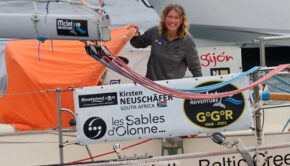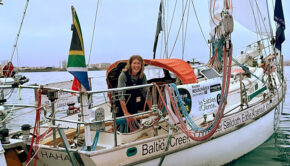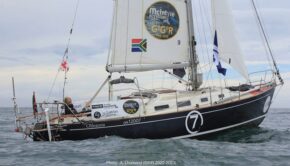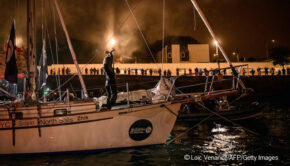New leader in Golden Globe Race
Published on January 31st, 2023
(January 31, 2023) – It was 149 days ago, on September 4, 2022, when 15 men and one woman set out on the 2022-23 Golden Globe Race from Les Sables d’Olonne, France. Their dreams and aspirations were to circumnavigate solo in the extreme Golden Globe Race.
In 1968, nine set out on the first such mission and only one finished. In 2018, 18 sailors set out and just five sailed home. Today only four of the original 2022 sailors are still racing the GGR non-stop towards Cape Horn. They have over 9,000 miles and many months still to go to the finish… anything can happen.
Out front is an extraordinary solo woman sailor quite unlike any other. Behind her are 15 extraordinary men who have either given up, or struggle to keep up. The GGR is a mind game, so physically and mentally tough, relentless and unforgiving, it sometimes beggars belief.
They are, or were all volunteers. They are all dreamers, adventurers and passionate about life, giving it their all to achieve something even they may not fully understand. The GGR is an amazing human story of courage and determination unfolding before our eyes.
Unable to repair his Hydrovane self-steering system damaged at sea during a knock-down, race leader Simon Curwen (GBR) has retired from the GGR into Chichester Class and is heading North East for a Chilean Port to effect repairs.
With 70% of the total distance under his belt and a thousand–mile gap with his closest rivals, Curwen seemed untouchable a week ago as he was screaming down the 50s on his way to Cape Horn when a crucial piece of his hydrovane broke when the boat was knocked-down on January 27.
He tried to emulate his hero Sir Robin Knox Johnston who steered Suhaili to the finish, and to victory in the original 1968 GGR, without a windvane for the last stretch of that voyage. Balancing sails, however, proved harder on his cutter rigged Biscay 36 than on the ketch rigged Suhaili and Curwen was making slow progress. This would potentially expose himself to future storms in the weeks ahead while attempting to round Cape Horn under duress.
“I tried all sorts of options for several days to make this boat go downwind and she doesn’t want to,” said Curwen. “I was bullish yesterday with the southwesterly but now I can’t get her to go in the right direction.
“With all those weather systems coming through with no ability to steer a course, I have to think about safety. Apart from risk to me and the boat, there is also potential risk for any person who may have to come and rescue me.”
The Race Office advised alternative ports on the west coast of Chile, where the Briton could safely moor, receive the part and replace it in a timely manner.
With a lee shore approach, Race Control is monitoring and assisting navigation and giving regular weather updates. He has been given a special exemption to use his emergency GPS to ensure maximum safety in the coming days.
It’s a heartbreaking decision for the charismatic sailor who has led the fleet since Cape Finisterre, but a wise one.
Kirsten Neuschäfer (RSA), with the fastest boat in the fleet this week, taking the lead with just four racing for line honors.
After diving three times last week for a total of 8 hours to remove barnacles, she has scored the best 24-hour distance at 185.6 miles, but also this morning the best Weekly distance at 1129.5 miles. This enabled her to catch-up on an resting Abhilash Tomy (IND) on January 28 and to now lead the Golden Globe Race!
Tomy a solid second, is again dealing with setbacks for his body and his boat
It was in the 2018 GGR that he suffered a serious accident when his boat Thuriya, an ERIC 32 replica of the original Suhaili, was rolled over and dismasted in the Indian Ocean, prompting a text-book rescue and recovery involving the Indian and French Government. His injury was a seriously damaged back requiring heavy surgery and significant recovery to regain his mobility.
Problems have occurred again when he fell on his back in the Indian Ocean, and was steering by hand last week for 12 hours during a gale and soon after was plagued by back pain and numb limbs.
He spoke to his Doctors in India who gave him exercises to regain control of his leg, as well as the official race doctors MSOS for pain treatment. He was advised to rest and mend himself for a few days before attending to his Rustler 36 Bayanat’s extensive to-do list prior to diving to Cape Horn, including rigging and mainsail track maintenance and repairs.
He is now sailing to keep the boat comfortable under reduced sails, rather than racing downwind. This is making his route longer and slower than Neuschäfer’s Cape George 36, which has struggled to catch up to Bayanat in the Southern Pacific so far. This may last a few more days yet as Tomy is safe and does not require any assistance and is in complete control. He knows he must rest now, so the pains do not return again. GGR is closely monitoring the situation.
Leaving Les Sables d’Olonne was hard on the rescued sailor as he suffered post – traumatic stress during the first 10 days of the race, unable to eat anything. He recovered but crashed again during the Cape Town film drop, declaring the GGR was “not a race” but just a game of chance and that he was not racing anymore.
He thought he had put his demons behind him when he passed the Indian Ocean longitude of his rescue and was excited and happy at the Hobart film drop to be back in the game! Now the memories are back haunting him in a physical rather than psychological way.
The revelation of the Pacific definitely is Michael Guggenberger (AUT), now in third, has found the manual to get his ketch-rigged Biscay 36 Nuri go fast and steady, matching the speeds of the other Biscay in the fleet. Although still 1200 miles back of the runners-up, Nuri has not lost ground on the most experienced sailors of the fleet.
It’s not only the pace of Nuri that forces respect. New to sailing 10 years ago, Guggenberger has matched both the pace and the preparation level of much more experienced sailors, presenting no significant damage after 18000 grueling miles in the GGR. His only issue being depleting water reserves, holding until March 19 at 1.5 litre/day.
The last GGR sailor in Suhaili Class, playing the game of attrition with success is Ian Herbert-Jones (GBR). So many times since Les Sables d’Olonne he has questioned his GGR reality and seriously considered stopping. The boat is fine, but the isolation and lack of contact with family and friends has pushed him to the limit! Arriving 5th into Hobart swept all that away for good. He is apprehensive about Cape Horn, but he is ready and he is now sailing home!
He left Hobart one day after Jeremy Bagshaw (RSA) now in Chichester Class who stopped for a few days to clean his barnacle infested hull. Both made the fastest Tasman Sea crossing of the fleet, in a mere 8 days, a week faster than others.
They will get plenty of northerlies this week sending them quickly north of the exclusion zone and into their Southern Pacific ride.
Guy Waites (GBR) has been battling consistent heavy weather the past four days under Australia with more to come. He has been sailing under bare poles towing warps often. Another large low-pressure is on the way with 11mtr seas and 50-60 knot winds forecast. Waites is tired, but getting ready. He confirmed all is well onboard Sagarmatha and looking forward to a break. He did not make the mandatory Hobart gate on time, and will be retired from the GGR once passing the longitude of Hobart.
Event details – Entry list – Tracker – Facebook
Credit for helping with rescue of Tapio Lehtinen:
• Kirsten Neuschäfer: 35 hours + 30 litres of fuel
• Abhilash Tomy: 12hrs
2022 GGR Class:
Abhilash Tomy (43) / India / Rustler 36
Ian Herbert Jones (52) / UK / Tradewind 35
Kirsten Neuschäfer (39) / South Africa / Cape George 36
Michael Guggenberger (44) / Austria / Biscay 36
2022 GGR Chichester Class:*
Guy Waites (54) / UK / Tradewind 35 (stopped in Cape Town to clean/paint hull)
Jeremy Bagshaw (59) / South Africa / OE32 (stopped in Hobart to clean hull)
Simon Curwen (63) / UK / Biscay 36 (will stop to repair windvane)
* Competitors shift to this class by making one stop.
Retired
Edward Walentynowicz (68) / Canada / Rustler 36 (dropped out, Sept. 8)
Guy deBoer (66) / USA / Tashiba 36 (ran aground, Sept. 16)
Mark Sinclair (63) / Australia / Lello 34 (retired in Lanzarote, Sept. 22)
Pat Lawless (66) / Ireland / Saga 36 (retired in Cape Town, Nov. 9)
Damien Guillou (39) / France / Rustler 36 (retired in Cape Town, Nov. 14)
Ertan Beskardes (60) / UK / Rustler 36 (retired in Cape Town, Nov. 16)
Tapio Lehtinen (64) / Finland / Gaia 36 Masthead sloop (sank off Cape Town, Nov. 18)
Arnaud Gaist (50) / France / BARBICAN 33 MKII-long keel version (retired near Saint Helena, Dec. 9)
Elliott Smith (27) / USA / Gale Force 34 (retired, Dec. 20)
About the 2022 Golden Globe Race
On September 4, 2022, the third edition of the Golden Globe Race started from Les Sables d’Olonne, France. Sixteen skippers will face eight months of isolation sailing 30,000 miles before finishing in Les Sables d’Olonne. Along the route there are several marks of the course and media requirements.
In 1968, while man was preparing to take his first steps on the moon, a mild mannered and modest young man was setting out on his own record breaking voyage of discovery. He had entered the original Golden Globe. Nine men started that first solo non-stop sailing race around the World. Only one finished. He was 29 year old Sir Robin Knox Johnston. History was made. Navigating only with a sextant, paper charts and an accurate and reliable time piece, Sir Robin navigated around the world.
In 2018, to celebrate 50 years since that first record breaking achievement, the Golden Globe Race was resurrected. It instantly gained traction with adventurers, captivated by the spirit and opportunity. Eighteen started with five finishers.
To embrace the original race, competitors must sail in production boats between 32 and 36 feet overall and designed prior to 1988 that have a full-length keel with rudder attached to their trailing edge. Additionally, sailors have limited communication equipment and can use only sextants, paper charts, wind up clocks, and cassette tapes for music.
Source: GGR









 We’ll keep your information safe.
We’ll keep your information safe.